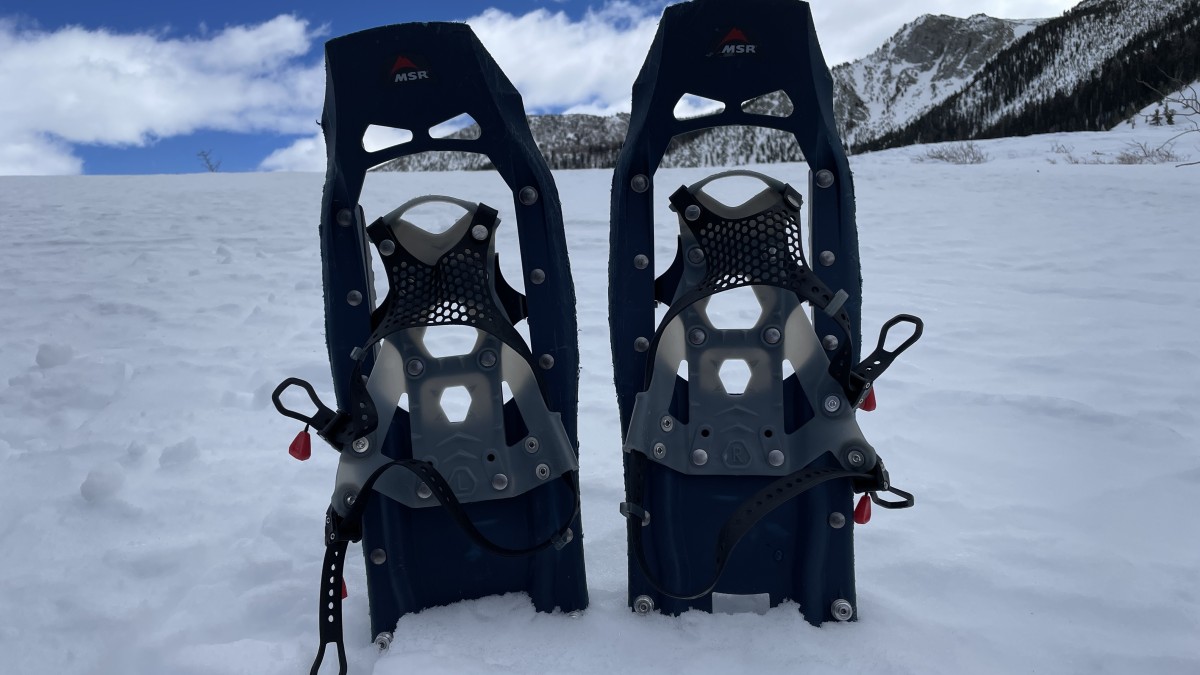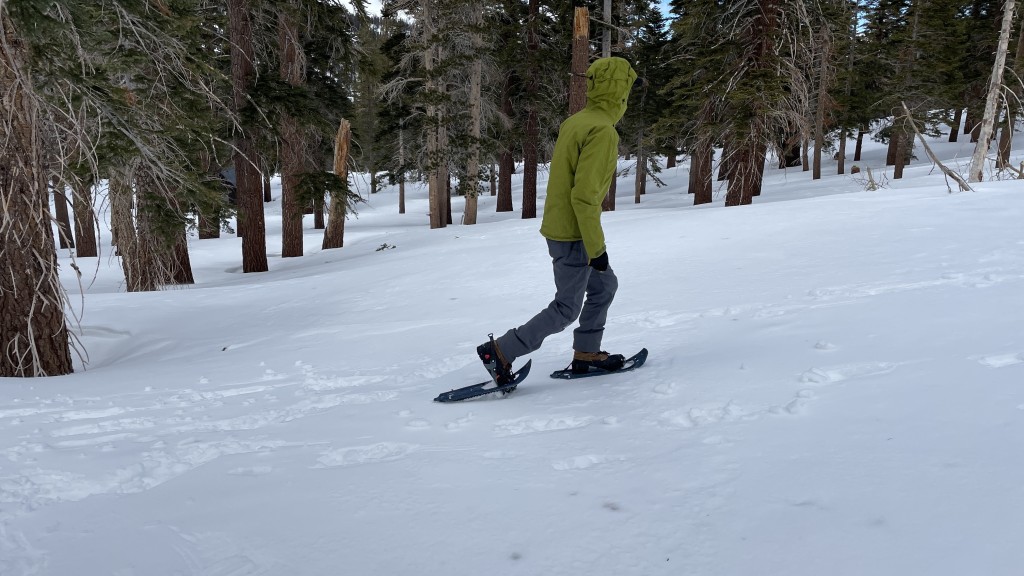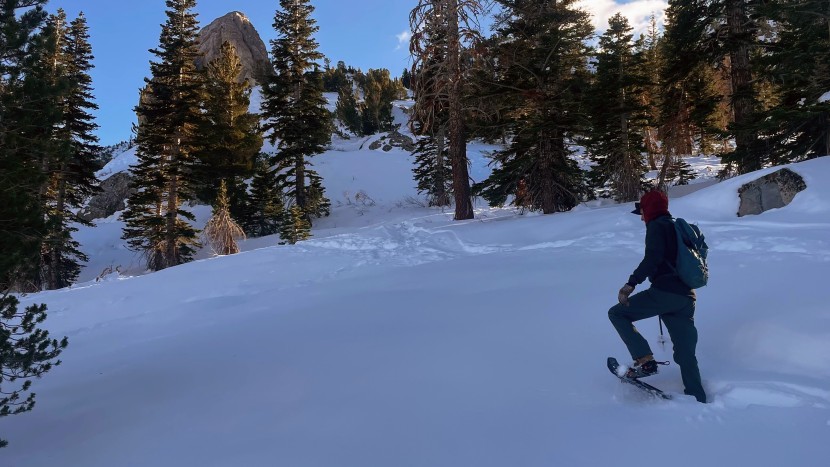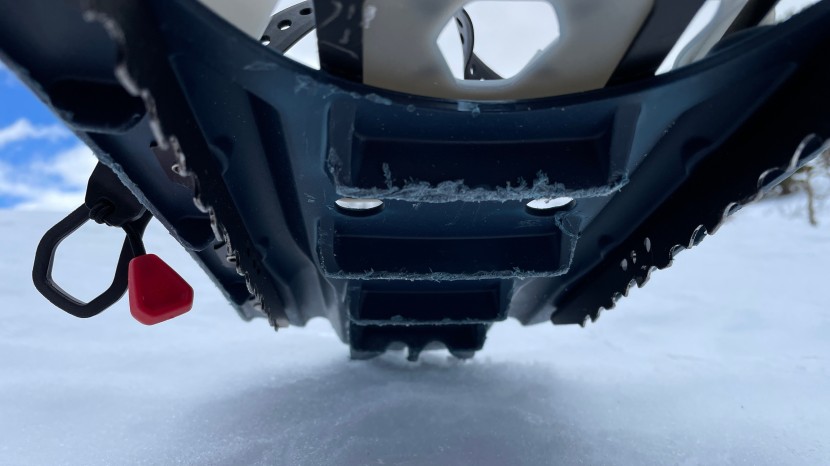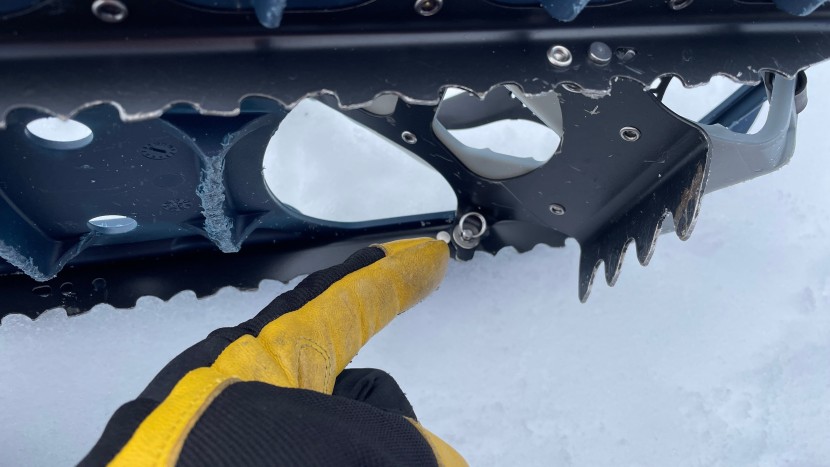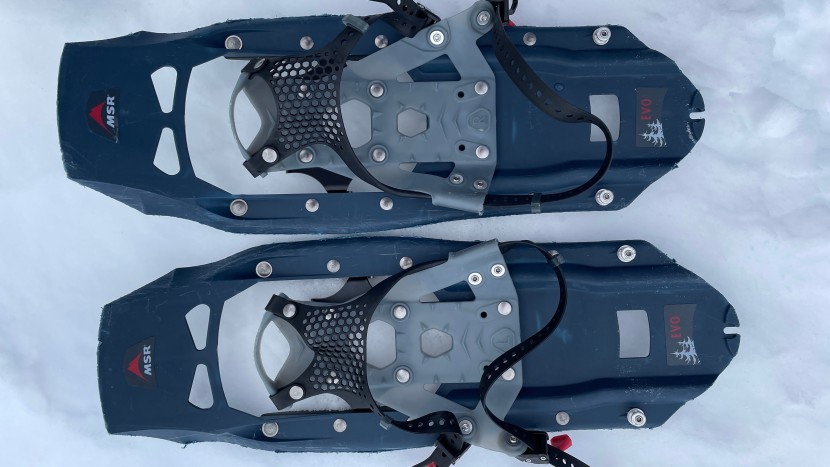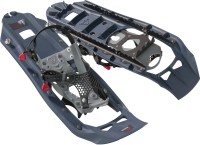
Our Verdict
Our Analysis and Test Results
MSR has been making plastic snowshoes for a very long time. Over the years, those models have ranged from those aimed at the technical mountaineer to models designed for small children and everyone in between. All have featured a wallet-friendly price, simple design, and versatility suitable for a wide range of experience levels and terrain conditions. They also tend to be quite durable and are often chosen for rental fleets.
Flotation
Flotation is a snowshoe's number one job. The deck and frame of the Evo Trail is a single plastic mold that is lightweight. This design initially had us wondering how well it would manage in different snow conditions, and we were pleasantly surprised to find it excels on packed and fresh snow.
A rigid deck can give a snowshoe more flotation than the surface area alone might imply. The single piece of plastic comprising the Evo deck is quite stiff, and two longitudinal steel rails on each snowshoe also contribute to fore-to-aft stiffness. The short frame length is only available in a single size. At 22 inches, the Evo is best for packed snow and off-trail travel in steep terrain. MSR also sells add-on flotation tails that increase the length by six inches, augmenting the flotation noticeably. Though these increase flotation, they make the Evo less maneuverable. They're a good choice for folks who occasionally carry a heavy pack or venture out in regions with a very variable snowpack. We think most hikers will usually be okay without the tails.
Traction
Increased traction is the second most important benefit we get from a snowshoe. The semi-aggressive traction system on the Evo Trail is best suited for groomed trails, packed snow, rolling hills, and steeper slopes. Only the gnarliest of terrain and conditions might justify burlier traction.
The crampons are on a full rotation-pivot binding for an unencumbered range of motion. Three brake bars are designed into the plastic deck and perform well on moderate rolling terrain, resisting slipping on the way up and especially on the way down. The underfoot crampon teeth and lateral crampons are made from powder-coated steel. The underfoot crampons dig into hard-packed snow for security through each stride, while the lateral crampons are best for side-stepping and provide some uphill and downhill traction as well. Additionally, our testers found that the rigid deck was great for cutting into the snow while side-hilling. One tester commented, “The rigidity lets me use the uphill edge of the deck to create a level platform to stand on, which is really nice when I am breaking trail for a group.”
Walkability
Energy-efficient walking is what we want, and our testers found that the short length of the Evo made walking a little more natural. The compact size is nice on trails and firmer snow and feels less cumbersome for first-time snowshoers to hike in. A shorter snowshoe is also generally more agile and easier to walk down steep slopes in. Both of these are important qualities on rough, almost technical, alpine terrain.
Couple that with the precision of a hinged binding, and the diminutive Evo can sometimes be an appropriate choice for steep, big-mountain terrain. Drawbacks include the loud nature of the plastic decking, the lack of shock absorption in the rigid hinge and deck combination, and the fact that there was no rocker in the back deck of the snowshoe. Those qualities make this model feel (and sound) a little clunky on packed-out or groomed trails.
Bindings
The Evo Trail is one of the easiest snowshoes to use in our lineup. Novice snowshoers will appreciate the simple unibody design that lacks daunting features and components. One of our testers mentioned, “I can't imagine ice or snow ever being a problem with these simple bindings”.
Putting these on is as simple as placing your boot on the snowshoe and pulling on two straps. Taking them off is equally simple or even easier if you use the same boots later. This is because the forward strap can be left in position, and your boot can be wiggled in and out of the rubber “net”. Add-on flotation tails (sold separately) are easy to attach for increased stability and flotation. However, without the tails, the short length makes strapping the Evo to the outside of a pack among the least punishing of our tested models. This snowshoe also travels well in a car or checked baggage.
Regardless of what snow conditions our testers encountered or what shoes we had on our feet, the Evo Trail remained securely fastened with no question of security. The rubber “net” over the forefoot tightens securely and distributes that force nicely, even in softer shoes. Our testing team has observed that hikers new to snowshoeing need practice striking a balance between having the straps too tight and too loose, and the net on the Evo makes this less of a fine line.
The heel is held in place with a simple rubber strap. Both straps are secured with the same plastic buckle, which is spring-loaded. This means the buckle “wants” to stay in the closed position, making it unlikely to pop open unintentionally. The lever on the buckle has a glove-friendly pull tab. Also, both buckles are on the outside of your foot, where they're less likely to contact the other snowshoe.
Should You Buy the MSR Evo Trail?
The Evo Trail is durable, easy to use, and versatile enough for novices and experts alike. Some of our testers have used this snowshoe for many years with no problems, even in rowdy, mountainous terrain. Conversely, they're simple enough for a casual stroll on a groomed trail. We think they're great for most winter hikers most of the time.
What Other Snowshoes Should You Consider?
Those looking for a cheaper and even more basic model, perhaps for the occasional dog walk, short hike to a snowed-in cabin, or winter roadside emergencies, should check out the GoPlus - they are great for casual use. Hikers who expect to be traveling in the deepest of the deep snow - but not mountainous ground - should click on over to our review of the high-flotation Crescent Moon Big Sky 32.
| Awards | High Performance Affordability |
|---|---|
| Price | $170 List Check Amazon (on sale!) |
Overall Score  |
|
| Star Rating | |
| Bottom Line | This affordable molded snowshoe offers widespread appeal for its reliability and its compatibility with add-on tails that improve flotation |
| Pros | Inexpensive, simple, reliable |
| Cons | Loud decking on crusty snow |
| Rating Categories | MSR Evo Trail |
| Flotation (30%) | |
| Traction (30%) | |
| Walkability (20%) | |
| Bindings (20%) | |
| Specifications | MSR Evo Trail |
| Measured Weight (per pair) | 3.7 lbs |
| Sizes Available | 22" (one size) |
| Binding System | Rubber net and straps with pin-in-hole |
| Frame Material | Martensitic steel |
| Measured Surface Area | 183 sq in |
| Measured Dimensions | 24"L x 8"W |
| Binding/Deck Connection | Hinged |
| Crampon/Traction Aids | Steel crampons and rails |
| Deck Material | Polypropylene |
| Heel Lift | No |
| Flotation Tails Sold Separately | Yes |
| Men's/Women's Versions Available | Unisex |
| Optimum Weight Load (per manufacturer) | up to 180 lbs |
| Tested Size | 22" |


